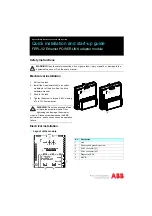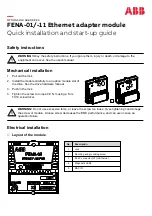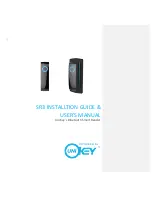
- 3 -
IV. ALARM AND SENSOR INSTALLATION
Alternator Temperature Sensor
(MC-TS-A) - Optional
The Alternator Temperature Sensor enables the regu-
lator to sense when the alternator temperature exceeds
safe working limits. The MC-624 responds by reducing
the field current at the alternator and activating the
alarm output. To install the Alternator Temperature
Sensor:
1.
Attach the positive and negative wires to the
Alternator Temperature Sensor terminals on the
MC-624 (See
Figure 4
). See
Figure 3
on previ-
ous page for pin locations. Observe proper polar-
ity at the terminals.
2.
Attach the heavy lug terminal to a location
described below on your alternator. Flat wash-
ers are included with the temperature sensors to ensure solid mounting connections.
The following are typical installation locations:
MID CASE MOUNT -
Small Case Alternator - Remove (1) of (4) 5/32" Allen bolts,
install probe, re-secure bolt. (See
Figure 5
.)
MID CASE MOUNT -
Large Case Alternator - Remove (1) of (4) 3/16" Allen bolts,
install probe, re-secure bolt.
Caution:
The alternator temperature sensor is not meant to be used as a method to main-
tain alternator temperature. Optional temperature sensors are not a guarantee of protection
against damage from overheat conditions. Inspect your system as quickly as possible if the
sensor alarm is activated. Have your system inspected if overheating occurs.
Battery Temperature Sensor (MC-TS-B) - Optional
When equipped with the optional Battery Temperature Sensor, the MC-624 will auto-
matically compensate for variation above and below normal ambient temperatures. The
MC-624 is equipped with dual battery sensors to enable sensing at two separate bat-
teries. To ensure proper operation, be sure the battery terminals are completely clean
and free of corrosion prior to installation. To install:
1.
Secure the 3/8" copper probe to a clean negative (-) battery terminal (see
Figure 6
). The 20' leads may be shortened or extended, if needed. Note: An
improperly installed or corroded battery terminal may generate heat and severe-
ly diminish charging and impede accurate temperature sensing.
2.
While observing polarity, connect the battery temperature pins to the positive and
negative terminals as shown on
Figure 4
.
Note:
Battery #1 terminal temperature compensates andactivates alarm. Battery #2 terminal activates the warning alarm only.
Lamp / Alarm Outputs
The MC-624 includes an output terminal for system alarms (dash lamp). This terminal outputs battery negative (0.5-amp max)
when in alarm condition. Refer to
Figure 7
for common system conditions that may initiate an alarm.
Small Engine Mode
The MC-624 can be modified for provide a half-power setting by installing a toggle switch between the positive and negative
terminals of the alternator temperature sensor circuit. When activated by closing the switch, the regulator reduces the alterna-
tor output by approximately 50%. This mode is ideal for smaller engines that are not capable of providing suitable horsepower
to drive both the alternator and propeller at full output. When in Small Engine Mode, the regulator will send a signal to the
Auxiliary #1 Status Output.
V. SHORT DISPLAY
The Model MC-624 provides a wide range of operational, programming and diagnostic data through its 3-digit numeric LED
readout. After an initial start-up period, the numeric LED will cycle through the
Short Display,
shown in
Figure 8
on the fol-
lowing page. The short display includes manufacturer, model, battery type, charging cycle, actual voltage and target voltage.
This display cycles continuously during regulator operation.
Figure 4
-
Proper attachment of
optional battery and alternator temp
sensors at the regulator.
Figure 5 -
Mounting temperature
sensor mid-case on small case
alternator.
Figure 6 -
Mounting temperature
sensor on battery.
Alarm Output Functions
Alarm Output (Dash Lamp)
(-) 0.5 amp - when in alarm mode
•
Low battery voltage (030)
•
High battery voltage (040)
•
High temperature at battery #1 (020)
•
High temperature at battery #2 (021)
•
High temperature at alternator (022)
Figure 7 -
Alarm output functions.


























